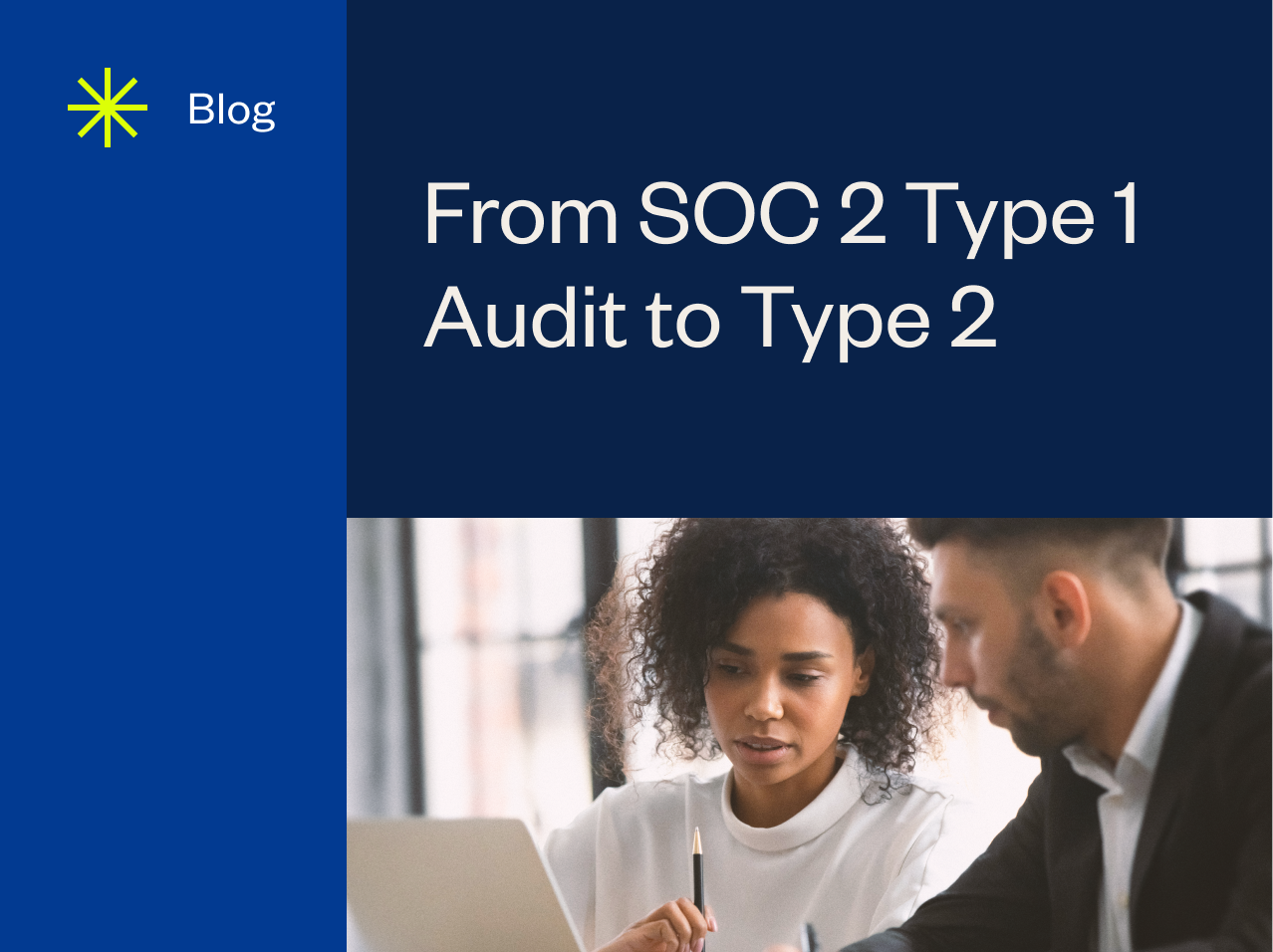Moving from a SOC 2 Type 1 Audit to a Type 2

At a time when cyber-attacks are occurring at unprecedented rates, maintaining information security is paramount. Organizations can demonstrate their commitment to data security by undergoing a SOC 2 audit, which assesses the controls designed to protect an organization’s system or services. There are two types of SOC 2 audits: Type 1 and Type 2. Many organizations elect to start with a Type 1 audit, and later move to a Type 2.
In this article, we explore the two types of SOC 2 audits, the process of moving from a SOC 2 Type 1 audit to a Type 2, and the value they each bring.
SOC 2: Type 1 and Type 2
Any SOC 2 audit will evaluate your internal security management system based on one or more of the following five categories: Security (required), Availability, Processing Integrity, Confidentiality, and Privacy. The difference between a Type 1 and Type 2 audit is largely (but not entirely) based on time.
- Type 1: This assessment evaluates the design of internal security controls at a single point in time – perhaps on a specific date: February 1.
- Type 2: This assessment evaluates the design and effectiveness of internal security controls over a duration of time – perhaps a 12-month period starting on February 1.
A Type 2 audit is more comprehensive because it seeks to examine not just the design of security controls, but how the controls work on a daily basis. A Type 2 report is more robust than a Type 1 report as it covers a span of time and tests an array of samples across the different high-risk areas.
So why might an organization that has undergone a Type 1 decide later to undergo a Type 2?
The Process of Moving from a SOC 2 Type 1 to a Type 2
Even if your organization previously completed a Type 1 audit, you should expect to invest additional time and resources into the process of completing a SOC 2 Type 2. The biggest difference in moving to a Type 2 is the quantity of sample evidence that is requested, as a Type 1 report only looks at one sample.
The first step in the SOC 2 Type 2 audit process is to determine the length of the review period. Type 2 audits typically cover a one-year period, but can vary based on contractual requirements between an organization and its clients. Once the review period has been determined, the organization and its auditor will have walkthrough meetings (similar to a Type 1 audit) to understand the security processes and procedures that have been put in place.
Each auditing firm has a sampling methodology that is used and is driven by AICPA (American Institute of Certified Public Accountants) guidance. Expect your auditor to request multiple samples, and for them to review various population pulls within the designated time period. Samples might be pulled from an annual, quarterly, monthly, or daily basis, depending on the frequency and nature (manual vs automated) of the controls being tested.
Moving from a Type 1 to a SOC 2 Type 2
While a SOC 2 Type 1 audit signals to partners and clients (both current and prospective) that you take information security seriously, there are instances where it would be beneficial to pursue a Type 2. These include:
- Contractual obligations – A customer might request that your company obtain a Type 2 report and might even define the length of the review period (six months, nine months, a year, etc.).
- To develop rapport with clients – Business is built on trust and moving to a Type 2 helps give assurance to your clients that their information is in good hands.
- To build brand recognition/competitive advantage – Undergoing a Type 2 audit is more time-intensive than a Type 1, and so completing the assessment demonstrates your company’s dedication to security. This can set your business apart from competitors.
What is the Value of Moving from a SOC 2 Type 1 to a SOC 2 Type 2?
While a SOC 2 Type 1 report confers benefits to organizations by demonstrating their commitment to information security, a SOC 2 Type 2 report has even greater value. This report shows that an organization has not only designed controls, but they were operating effectively through the determined review period. It can therefore be concluded that the organization is capable of maintaining information security.
Value can also be gained through building an environment that is focused on streamlining regulatory compliance efforts. Organizations that only undergo a Type 1 audit are likely to maintain defined controls once a year. But when going through a Type 2 audit, the organization must monitor and maintain controls throughout the full year. This helps in streamlining and reinforcing policies and procedures among team members on an ongoing basis.
Thinking about moving from a SOC 2 Type 1 to a Type 2? A-LIGN can help you navigate the process. We’re more than an auditor. We’re a partner that has completed over 5,000 SOC 2 reports and the top SOC 2 issuer in the world. Contact us to get started on your SOC 2 Type 2 journey.
